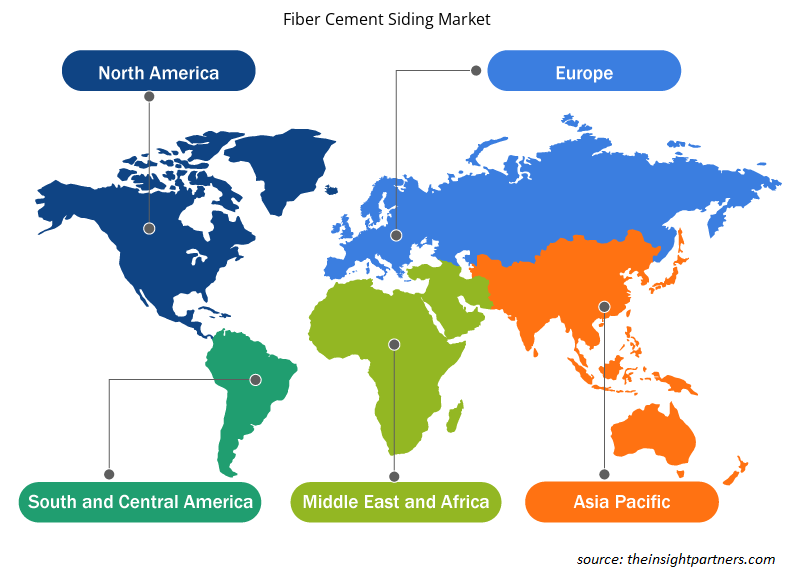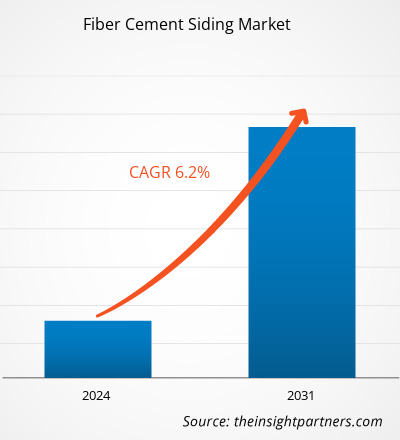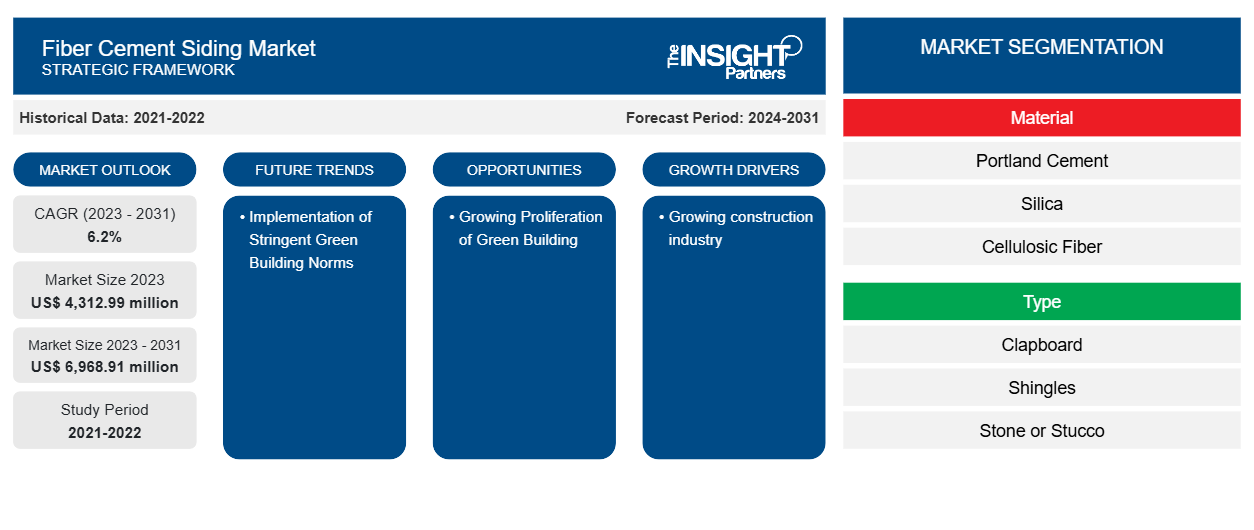La taille du marché des revêtements en fibrociment devrait atteindre 6 968,91 millions USD d'ici 2031, contre 4 312,99 millions USD en 2023. Le marché devrait enregistrer un TCAC de 6,2 % au cours de la période 2023-2031. Le nombre croissant de développements d'infrastructures résidentielles et commerciales et l'accent croissant mis sur l'exploitation de revêtements en ciment rentables devraient rester une tendance clé du marché.
Analyse du marché des revêtements en fibrociment
Le développement croissant du secteur de la construction devrait accroître le développement des revêtements en fibrociment à l'échelle mondiale. Le secteur de la construction dans les pays développés tels que les États-Unis, le Canada et le Royaume-Uni, entre autres, a connu une croissance importante au cours des dernières années. Les gouvernements de ces pays encouragent les partenariats public-privé pour la mise en œuvre de travaux résidentiels, commerciaux et d'infrastructure. Cela a conduit à une augmentation de la construction de bâtiments résidentiels et commerciaux à l'échelle mondiale ces derniers temps, ce qui encourage la croissance du marché des revêtements en fibrociment.
Aperçu du marché des revêtements en fibrociment
L'augmentation de la construction de bâtiments résidentiels et commerciaux devrait offrir des opportunités prospères pour que le marché se développe à l'échelle mondiale, ce qui aura un impact positif sur la demande de revêtements en fibrociment. Parallèlement à cela, les projets de villes intelligentes agissent également comme un moteur du marché des revêtements en fibrociment. L'augmentation des revenus disponibles des particuliers en raison de la prospérité économique a été un facteur majeur de stimulation du marché des revêtements en fibrociment dans le secteur des bâtiments résidentiels. Ainsi, le nombre croissant d'activités de construction entraîne une demande positive de revêtements en fibrociment à l'échelle mondiale.
Personnalisez ce rapport en fonction de vos besoins
Vous bénéficierez d'une personnalisation gratuite de n'importe quel rapport, y compris de certaines parties de ce rapport, d'une analyse au niveau des pays, d'un pack de données Excel, ainsi que de superbes offres et réductions pour les start-ups et les universités.
-
Obtenez les principales tendances clés du marché de ce rapport.Cet échantillon GRATUIT comprendra une analyse de données, allant des tendances du marché aux estimations et prévisions.
Facteurs moteurs et opportunités du marché des revêtements en fibrociment
Le développement croissant du secteur de la construction favorise le marché
La croissance démographique a entraîné une forte demande en matière de construction résidentielle et commerciale à l'échelle mondiale. Des régions comme l'Europe, l'Amérique du Nord, l'Asie-Pacifique et le Moyen-Orient comprennent plusieurs pays en développement, qui génèrent une forte demande en projets d'infrastructures. La croissance démographique de ces pays est le principal moteur de l'industrie du logement de la région, ce qui stimulera le marché mondial du bardage en fibrociment. Avec l'essor de la construction de bâtiments commerciaux et résidentiels, le marché du bardage en fibrociment augmente dans plusieurs pays comme la Chine et le Japon en raison de plusieurs avantages tels que les économies d'énergie et de coûts à long terme, la réduction des émissions et de l'impact environnemental global, un meilleur confort thermique et une ventilation continue et de l'air frais dans tout le bâtiment, ce qui améliore le confort et la santé. Le concept croissant de bâtiments économes en énergie stimule également la croissance du marché du bardage en fibrociment.
Prolifération croissante des bâtiments écologiques
Plusieurs initiatives gouvernementales visant à introduire des bâtiments économes en énergie et respectueux de l'environnement stimulent la demande pour le marché des revêtements en fibrociment. Par exemple, l'Allemagne et le Royaume-Uni sont les principaux pays qui se concentrent sur la construction de bâtiments économes en énergie en raison des investissements gouvernementaux respectifs. Ce facteur stimule la croissance du marché des revêtements en fibrociment. Les progrès technologiques pour le développement des secteurs de l'habitation résidentielle et commerciale conformément aux objectifs de durabilité environnementale devraient attirer les acteurs locaux et mondiaux pour proposer des revêtements en fibrociment de qualité, qui devraient accroître les opportunités pour le marché au cours de la période de prévision.
Analyse de segmentation du rapport sur le marché des revêtements en fibrociment
Les segments clés qui ont contribué à l’élaboration de l’analyse du marché des revêtements en fibrociment sont le type de produit, l’application et l’utilisateur final.
- En fonction du matériau, le marché des revêtements en fibrociment est divisé en ciment Portland, silice, fibre cellulosique et autres. Le segment du ciment Portland détenait une part de marché plus importante en 2023.
- Par type, le marché est segmenté en bardeaux, en bardeaux et en pierre ou stuc. Le segment des bardeaux détenait une part importante du marché en 2023.
- En fonction de l'utilisateur final, le marché est segmenté en résidentiel et commercial. Le segment résidentiel détenait une part importante du marché en 2023.
Analyse des parts de marché des revêtements en fibrociment par zone géographique
La portée géographique du rapport sur le marché des revêtements en fibrociment est principalement divisée en cinq régions : Amérique du Nord, Asie-Pacifique, Europe, Moyen-Orient et Afrique, et Amérique du Sud et centrale.
L'Amérique du Nord est en tête du marché. L'économie de l'Amérique du Nord est considérée comme l'une des plus importantes au monde. Les pays d'Amérique du Nord abritent certaines des plus grandes multinationales sur leurs territoires. Les États-Unis comptent un plus grand nombre d'acteurs sur le marché du bardage en fibrociment par rapport au reste du monde. Les entreprises de construction situées dans la région bénéficient des installations développées disponibles. Une économie robuste permet au gouvernement de dépenser davantage pour les travaux de construction en vue d'une plus grande urbanisation. Cela contribue également à la construction de bâtiments dans la région, ce qui soutiendra la croissance du marché du bardage en fibrociment dans la région.
Aperçu régional du marché des revêtements en fibrociment
Les tendances régionales et les facteurs influençant le marché des revêtements en fibrociment tout au long de la période de prévision ont été expliqués en détail par les analystes d’Insight Partners. Cette section traite également des segments et de la géographie du marché des revêtements en fibrociment en Amérique du Nord, en Europe, en Asie-Pacifique, au Moyen-Orient et en Afrique, ainsi qu’en Amérique du Sud et en Amérique centrale.

- Obtenez les données régionales spécifiques au marché des revêtements en fibrociment
Portée du rapport sur le marché des revêtements en fibrociment
| Attribut de rapport | Détails |
|---|---|
| Taille du marché en 2023 | 4 312,99 millions USD |
| Taille du marché d'ici 2031 | 6 968,91 millions USD |
| Taux de croissance annuel composé mondial (2023-2031) | 6,2% |
| Données historiques | 2021-2022 |
| Période de prévision | 2024-2031 |
| Segments couverts |
Par matériau
|
| Régions et pays couverts |
Amérique du Nord
|
| Leaders du marché et profils d'entreprises clés |
|
Densité des acteurs du marché : comprendre son impact sur la dynamique des entreprises
Le marché des revêtements en fibrociment connaît une croissance rapide, tirée par la demande croissante des utilisateurs finaux en raison de facteurs tels que l'évolution des préférences des consommateurs, les avancées technologiques et une plus grande sensibilisation aux avantages du produit. À mesure que la demande augmente, les entreprises élargissent leurs offres, innovent pour répondre aux besoins des consommateurs et capitalisent sur les tendances émergentes, ce qui alimente davantage la croissance du marché.
La densité des acteurs du marché fait référence à la répartition des entreprises ou des sociétés opérant sur un marché ou un secteur particulier. Elle indique le nombre de concurrents (acteurs du marché) présents sur un marché donné par rapport à sa taille ou à sa valeur marchande totale.
Les principales entreprises opérant sur le marché des revêtements en fibrociment sont :
- Groupe Swisspearl SA
- CSR Limitée
- Elementia SAB DE CV
- Groupe ETEX
- Société de matériaux GAF
- James Hardie Industries Plc
Avis de non-responsabilité : les sociétés répertoriées ci-dessus ne sont pas classées dans un ordre particulier.

- Obtenez un aperçu des principaux acteurs du marché des revêtements en fibrociment
Actualités et développements récents du marché des revêtements en fibrociment
Le marché des revêtements en fibrociment est évalué en collectant des données qualitatives et quantitatives après des recherches primaires et secondaires, qui comprennent d'importantes publications d'entreprise, des données d'association et des bases de données. Quelques-uns des développements sur le marché des revêtements en fibrociment sont énumérés ci-dessous :
- Le groupe Swisspearl de Niederurnen, en Suisse, a acquis la société danoise Cembrit. (Source : Swisspearl Group, communiqué de presse, juin 2022)
- James Hardie Industries Plc a acquis un terrain à Melbourne, dans l'État de Victoria, pour y implanter une usine de panneaux de fibrociment. (Source : James Hardie Industries Plc, communiqué de presse, mars 2022)
Rapport sur le marché des revêtements en fibrociment et livrables
Le rapport « Taille et prévisions du marché des revêtements en fibrociment (2021-2031) » fournit une analyse détaillée du marché couvrant les domaines ci-dessous :
- Taille et prévisions du marché des revêtements en fibrociment aux niveaux mondial, régional et national pour tous les segments de marché clés couverts par le périmètre
- Tendances du marché des revêtements en fibrociment ainsi que dynamique du marché telles que les facteurs moteurs, les contraintes et les opportunités clés
- Analyse PEST et SWOT détaillée
- Analyse du marché des revêtements en fibrociment couvrant les principales tendances du marché, le cadre mondial et régional, les principaux acteurs, les réglementations et les développements récents du marché
- Analyse du paysage industriel et de la concurrence couvrant la concentration du marché, l'analyse de la carte thermique, les principaux acteurs et les développements récents du marché des revêtements en fibrociment
- Profils d'entreprise détaillés
- Analyse historique (2 ans), année de base, prévision (7 ans) avec TCAC
- Analyse PEST et SWOT
- Taille du marché Valeur / Volume - Mondial, Régional, Pays
- Industrie et paysage concurrentiel
- Ensemble de données Excel
Rapports récents
Rapports connexes
Témoignages
Raison d'acheter
- Prise de décision éclairée
- Compréhension de la dynamique du marché
- Analyse concurrentielle
- Connaissances clients
- Prévisions de marché
- Atténuation des risques
- Planification stratégique
- Justification des investissements
- Identification des marchés émergents
- Amélioration des stratégies marketing
- Amélioration de l'efficacité opérationnelle
- Alignement sur les tendances réglementaires























 Obtenez un échantillon gratuit pour - Marché des revêtements en fibrociment
Obtenez un échantillon gratuit pour - Marché des revêtements en fibrociment